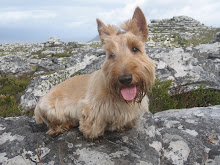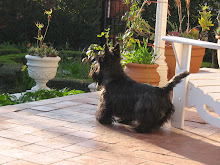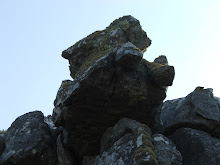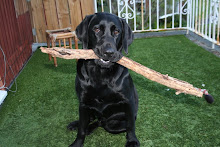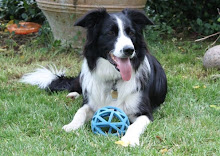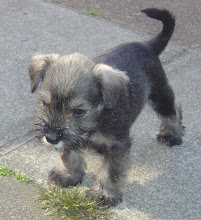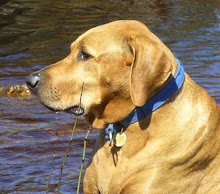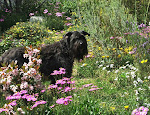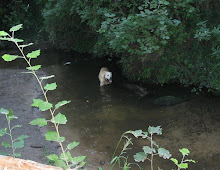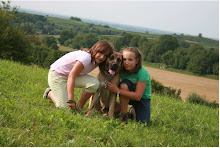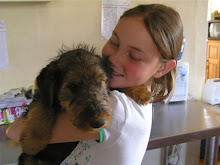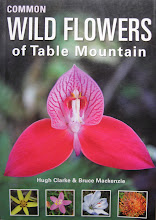 Seen on the le Roux's fridge. Well done Claude!
Seen on the le Roux's fridge. Well done Claude!  (Photo of Claude courtesy of Alice, my favourite human in all the world.)
(Photo of Claude courtesy of Alice, my favourite human in all the world.)
As told by Coco the Scottie
 Seen on the le Roux's fridge. Well done Claude!
Seen on the le Roux's fridge. Well done Claude!  (Photo of Claude courtesy of Alice, my favourite human in all the world.)
(Photo of Claude courtesy of Alice, my favourite human in all the world.)
 Today we discovered a wonderful new walk. The Food Lady has been part of the way before with the Friends of Silvermine and we have been to Kleinplaas Dam lots of times, but most of it was new territory. We met Alice and Maddie (everyone else was snug in their beds!) at the ghost town parking spot just before the Brooklands water plant at the end of the Pineview/Brooklands road off Red Hill Drive, and set off along the path to Kleinplaas Dam.
Today we discovered a wonderful new walk. The Food Lady has been part of the way before with the Friends of Silvermine and we have been to Kleinplaas Dam lots of times, but most of it was new territory. We met Alice and Maddie (everyone else was snug in their beds!) at the ghost town parking spot just before the Brooklands water plant at the end of the Pineview/Brooklands road off Red Hill Drive, and set off along the path to Kleinplaas Dam. The veld was burned quite recently and there were lots and lots of interesting plants popping up in the sandy veld including these little Winter Babianas (Babiana villosula),
The veld was burned quite recently and there were lots and lots of interesting plants popping up in the sandy veld including these little Winter Babianas (Babiana villosula), and these odd little Snake Lilies (Ornithoglossum viride),
and these odd little Snake Lilies (Ornithoglossum viride), and the tiny little Winter Spike-lily (Wurmbea hiemalis) - which is endemic to the Cape Peninsula.
and the tiny little Winter Spike-lily (Wurmbea hiemalis) - which is endemic to the Cape Peninsula. We quickly got to the dam and discovered that the water had reached the measuring stick - last time it was high and dry. It is still quite an optimistic measuring stick though!
We quickly got to the dam and discovered that the water had reached the measuring stick - last time it was high and dry. It is still quite an optimistic measuring stick though! Maddie found the waves on the dam a bit snary.
Maddie found the waves on the dam a bit snary. and I became snared in a fairy circle. Round and round ...
and I became snared in a fairy circle. Round and round ... It was still too early for tea, so we set off along the dam wall in a northerly direction. We came across some luminous flowers called Vlamme (Gladiolus bonaespei),
It was still too early for tea, so we set off along the dam wall in a northerly direction. We came across some luminous flowers called Vlamme (Gladiolus bonaespei), and when the path forked, we took the right fork as we were enjoying the smell (and taste) of fresh horse dung littered around. The left fork is the main Hoerikwaggo Trail and no horses are allowed on it.
and when the path forked, we took the right fork as we were enjoying the smell (and taste) of fresh horse dung littered around. The left fork is the main Hoerikwaggo Trail and no horses are allowed on it. These Golden Sunshine Conebushes (Leucadendron laureolum) were glowing yellow, but the sky was getting darker and darker and eventually it started to rain.
These Golden Sunshine Conebushes (Leucadendron laureolum) were glowing yellow, but the sky was getting darker and darker and eventually it started to rain. We trudged along the sandy path, getting a bit worried that we were now heading off in a westerly direction when we needed to turn round and head back in a south-easterly one. This pretty pink, strongly aniseed-scented buchu bush (Agathosma lanceolata) was the same colour as Alice's rain jacket. (And in case you are wondering how a colour-blind dog can tell this, the Food Lady told me!)
We trudged along the sandy path, getting a bit worried that we were now heading off in a westerly direction when we needed to turn round and head back in a south-easterly one. This pretty pink, strongly aniseed-scented buchu bush (Agathosma lanceolata) was the same colour as Alice's rain jacket. (And in case you are wondering how a colour-blind dog can tell this, the Food Lady told me!) Luckily the path then swung round and before we knew it we had reached the Lewis Gay Dam and the tarred road.
Luckily the path then swung round and before we knew it we had reached the Lewis Gay Dam and the tarred road. Apparently Lewis Gay was a mayor of Simon's Town and an MP. The dam was built in the 1950s.
Apparently Lewis Gay was a mayor of Simon's Town and an MP. The dam was built in the 1950s. A short wet trudge up the road from the Water Purification Plant and the Dam,
A short wet trudge up the road from the Water Purification Plant and the Dam, and we were back at the car and home in time for tea: soggy but happy!
and we were back at the car and home in time for tea: soggy but happy!
 We are off to Daisy and Dougal is all ready and waiting in the land rover.
We are off to Daisy and Dougal is all ready and waiting in the land rover. So am I. Hoity toity on my new blanket.
So am I. Hoity toity on my new blanket. As we drove through Napier en route to Agulhas, we noticed lots of scarecrows hanging about,
As we drove through Napier en route to Agulhas, we noticed lots of scarecrows hanging about,  and when we stopped at our usual place for lunch (we were a bit too late for their breakfast!) there was a stary snary pig outside. We asked them why there were all these funny things around and were told ...
and when we stopped at our usual place for lunch (we were a bit too late for their breakfast!) there was a stary snary pig outside. We asked them why there were all these funny things around and were told ...  it was the Patatfees!
it was the Patatfees! But are these patat chips? No indeed they are not. They are potato chips. Patats are actually sweet potatoes. Its all rather difficult for a scotty brain to grasp, but the chicken pie was delicious even if we only got the tiniest of tiny tidbits.
But are these patat chips? No indeed they are not. They are potato chips. Patats are actually sweet potatoes. Its all rather difficult for a scotty brain to grasp, but the chicken pie was delicious even if we only got the tiniest of tiny tidbits. At Daisy we went for an afternoon stroll to Rasperpunt to investigate the fieldmice which kept us busy for ages,
At Daisy we went for an afternoon stroll to Rasperpunt to investigate the fieldmice which kept us busy for ages, before early supper and early bed.
before early supper and early bed. The next morning we drove to Agulhas, past the lighthouse which is apparently going to have a re-vamp very soon.
The next morning we drove to Agulhas, past the lighthouse which is apparently going to have a re-vamp very soon. The Alph went into our favourite shop to buy gas for the cooker and nearly fell over our friend the Border Collie. (Border Collies always have their mind on higher things like herding sheep.)
The Alph went into our favourite shop to buy gas for the cooker and nearly fell over our friend the Border Collie. (Border Collies always have their mind on higher things like herding sheep.)  We found these poor bokke all scommled around in a red machine outside the shop, which reminded the humans that there was an important rugby match later on. Luckily they could check the score on their cellphones. (We won!).
We found these poor bokke all scommled around in a red machine outside the shop, which reminded the humans that there was an important rugby match later on. Luckily they could check the score on their cellphones. (We won!). We then parked the land rover at the entrance to Agulhas and, guidebook in hand, we set out on the Spookdraai Staproete.
We then parked the land rover at the entrance to Agulhas and, guidebook in hand, we set out on the Spookdraai Staproete. The trail starts in the main road and goes past some ghostly white horses,
The trail starts in the main road and goes past some ghostly white horses, with ghost stone markers all along the way for humans to follow and dogs to send wee mail from.
with ghost stone markers all along the way for humans to follow and dogs to send wee mail from. It was Father's Day - but we wondered about the fathers in Agulhas. I have seen some lurching around after a night in the pub, but isn't it a bit early for lurching?
It was Father's Day - but we wondered about the fathers in Agulhas. I have seen some lurching around after a night in the pub, but isn't it a bit early for lurching? These buildings were apparently built during World War 2 as a secret radar base which was manned and controlled by a British Women's Unit. (The use of "manned" here is quite PC as its base is the Latin word for hand - manu.) The existing road that leads up the Sandberg to the TV-signal enhancer mast originally led to the radar apparatus. Mount Pleasant is now holiday houses.
These buildings were apparently built during World War 2 as a secret radar base which was manned and controlled by a British Women's Unit. (The use of "manned" here is quite PC as its base is the Latin word for hand - manu.) The existing road that leads up the Sandberg to the TV-signal enhancer mast originally led to the radar apparatus. Mount Pleasant is now holiday houses. In the grass along the road were all sorts of interesting flowers like these lachenalias - probably Lachenalia bulbifera,
In the grass along the road were all sorts of interesting flowers like these lachenalias - probably Lachenalia bulbifera, and lots of these strange little Hedgehog Lilies (Massonia pustulata).
and lots of these strange little Hedgehog Lilies (Massonia pustulata). The path suddenly left the streets of Agulhas and took off up the hill into the limestone fynbos.
The path suddenly left the streets of Agulhas and took off up the hill into the limestone fynbos. The Alph looking over Cape Agulhas from an old water tank. You can just see the lighthouse in the far distance.
The Alph looking over Cape Agulhas from an old water tank. You can just see the lighthouse in the far distance. Some wag painted around this natural foot shape in the limestone. There are lots of little holes in the limestone up here, most of them filled with miniature plants.
Some wag painted around this natural foot shape in the limestone. There are lots of little holes in the limestone up here, most of them filled with miniature plants. Another ghostly marker and a snary limestone cave. We heard a rumour that caracals are often seen in these caves.
Another ghostly marker and a snary limestone cave. We heard a rumour that caracals are often seen in these caves. The rare Limestone Pagoda (Mimetes saxatilis) which is endemic to limestone ridges from Pearly Beach to Struisbaai and is listed on the Red List of South African plants as Endangered.
The rare Limestone Pagoda (Mimetes saxatilis) which is endemic to limestone ridges from Pearly Beach to Struisbaai and is listed on the Red List of South African plants as Endangered. The Limestone Conebush (Leucadendron meridianum) looking over Agulhas.
The Limestone Conebush (Leucadendron meridianum) looking over Agulhas. Yet another plant endemic to these limestone ridges is the Limestone Blombos (Metalasia calcicola).
Yet another plant endemic to these limestone ridges is the Limestone Blombos (Metalasia calcicola). This pretty little flower has the most unfortunate name of Fineleaf Skunkbush (Chaenostoma revolutum). I know how it feels as I am often called a Skunkdog.
This pretty little flower has the most unfortunate name of Fineleaf Skunkbush (Chaenostoma revolutum). I know how it feels as I am often called a Skunkdog. The Food Lady wants me to include just two more limestone endemics before you all fall fast asleep, Euchaetis meridionalis (a type of buchu) that only occurs on limestone in the eastern part of the southern Overberg,
The Food Lady wants me to include just two more limestone endemics before you all fall fast asleep, Euchaetis meridionalis (a type of buchu) that only occurs on limestone in the eastern part of the southern Overberg,
 These strange puff balls in the middle of the path were all puffed out.
These strange puff balls in the middle of the path were all puffed out. Looking towards Struisbaai. The path then meandered down to the start.
Looking towards Struisbaai. The path then meandered down to the start. All in all this is a pretty fantastic walk through the limestone fynbos of the southern tip of Africa. We were all ready to lurch into a traditional Agulhas Sunday lurch afterwards.
All in all this is a pretty fantastic walk through the limestone fynbos of the southern tip of Africa. We were all ready to lurch into a traditional Agulhas Sunday lurch afterwards.
 A lovely sunny day after all the rain. Pecks is a good path to walk up as it has a tinkling stream all the way up for hot scots to slake their thirst and batty bouviers to dip in. Paul joined us this morning, as did Alice (still my best human in all the whole wide world) and Maddie.
A lovely sunny day after all the rain. Pecks is a good path to walk up as it has a tinkling stream all the way up for hot scots to slake their thirst and batty bouviers to dip in. Paul joined us this morning, as did Alice (still my best human in all the whole wide world) and Maddie. A pretty pink Metalasia daisies but the Food Lady is not sure if it is Metalasia densa or muricata.
A pretty pink Metalasia daisies but the Food Lady is not sure if it is Metalasia densa or muricata. This is also Metalasia something or other, growing right next to the pink version.
This is also Metalasia something or other, growing right next to the pink version. In the middle of the path were some scrophy little manuleas. (The genus name Manulea means flowers that resemble a hand.)
In the middle of the path were some scrophy little manuleas. (The genus name Manulea means flowers that resemble a hand.) Up and up Pecks path we plodded - the Alph leading the way.
Up and up Pecks path we plodded - the Alph leading the way. There were quite a lot of these rather strange purple brown Gladiolus maculatus flowers all the way up the path. They smell good to the humans but not to us.
There were quite a lot of these rather strange purple brown Gladiolus maculatus flowers all the way up the path. They smell good to the humans but not to us. I preferred the mousy smells in this clump of restios,
I preferred the mousy smells in this clump of restios,  or the promise of a lizard or tortoise under these (which are the male flowers of Hypodiscus aristatus - one of the few restios that coppice.)
or the promise of a lizard or tortoise under these (which are the male flowers of Hypodiscus aristatus - one of the few restios that coppice.)  Dougal gets so carried away in this kind of fynbos that he has to run to catch up with us.
Dougal gets so carried away in this kind of fynbos that he has to run to catch up with us. Maddy is not all that interested in rodents or lizards (she prefers dachshunds) and took a plunge into the stream instead.
Maddy is not all that interested in rodents or lizards (she prefers dachshunds) and took a plunge into the stream instead. Lachnaea grandiflora.
Lachnaea grandiflora. Othonna digitata.
Othonna digitata. and a phairy in a phluffy Phylica.
and a phairy in a phluffy Phylica. A quick photo of Erica corifolia
A quick photo of Erica corifolia then it was time for tea. A gourmet affair today
then it was time for tea. A gourmet affair today  with chocolates from Alice, Earl Grey tea, dates from Paul and
with chocolates from Alice, Earl Grey tea, dates from Paul and a really delicious new species of rusks from Paul. We got the usual Beano dog biscuits but the Food Lady slipped us some pieces of rusk which was yummy yummy yummy.
a really delicious new species of rusks from Paul. We got the usual Beano dog biscuits but the Food Lady slipped us some pieces of rusk which was yummy yummy yummy. During tea we tried to join a group of people and dogs who walked past, but the Food Lady caught us and wouldn't let us follow the gang; spoilsport. We then passed them on St James' Peak and nearly left Paul behind but he was just admiring the view and soon caught up again.
During tea we tried to join a group of people and dogs who walked past, but the Food Lady caught us and wouldn't let us follow the gang; spoilsport. We then passed them on St James' Peak and nearly left Paul behind but he was just admiring the view and soon caught up again. Me checking for baboons on the way down. Lakeside spread out below.
Me checking for baboons on the way down. Lakeside spread out below. Another erica - this one is Erica glabella subsp. glabella,
Another erica - this one is Erica glabella subsp. glabella, and another fairy in a King Protea.
and another fairy in a King Protea. A prickly Bristly Snakethistle (Cullumia setosa), and ...
A prickly Bristly Snakethistle (Cullumia setosa), and ...  what is that in one of the Food Lady's favourite plants, the silvery Silver Sweet Pea (Podalyria sericea)?
what is that in one of the Food Lady's favourite plants, the silvery Silver Sweet Pea (Podalyria sericea)? The teeniest tiniest little worm - non-photoshopped - hanging from this teeny tiny Stonecrop (Crassula saxifraga).
The teeniest tiniest little worm - non-photoshopped - hanging from this teeny tiny Stonecrop (Crassula saxifraga). Stopping for a baboon check on the way down; a flock of pigeons in the distance.
Stopping for a baboon check on the way down; a flock of pigeons in the distance. Dougal really really didn't want to come home so he had to be carried to the car! What a clot.
Dougal really really didn't want to come home so he had to be carried to the car! What a clot. 











(John Winter - 2009)
















